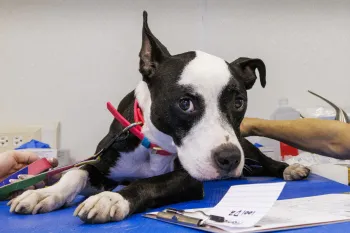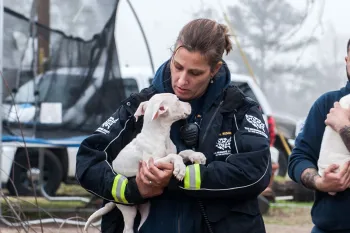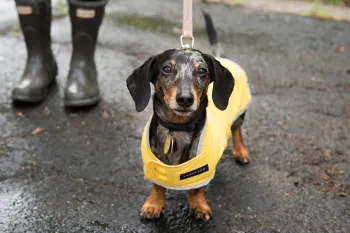I often tell stories of how our incredibly dedicated disaster response team deploys to help animals in the aftermath of devastating storms. But our teams work all year-round and all over the world to ensure that communities have plans in place to keep all residents safe, including the animal members of our communities. That work also involves educating individuals on the importance of emergency preparedness for their pets and other animals. Here, Celia Jackson, program director of disaster response for Humane World for Animals, gives an overview of what our team has been doing to help people prepare and how you can best equip your family’s companion animals for emergency situations.
What people face, so do animals. Floods, wildfires, volcano eruptions, hurricanes, typhoons, tornados, landslides, earthquakes—our Animal Rescue Team has sent help or deployed to regions around the world impacted by emergencies of all kinds. And these situations are only getting more frequent and severe for communities all over the world.
Responding to the urgent needs of animals and their people when disasters strike is a core part of our mission to alleviate suffering. But preparing communities before a disaster even happens can prevent injury, death and loss on a far larger scale, avoiding lives being put at risk in the first place. Disaster preparedness is essential to our team’s work. Preparedness goes beyond the boots-on-the-ground response. It may not grab the same headlines as a hurricane or a flood, but it is the steady work of preparation in some of the most vulnerable communities that can help people and their animals survive and come through even the worst of disasters.
Many communities that experienced disasters in the past want to increase their readiness to respond to emergency situations in the future. Our team works with communities all over the world, all year-round, during what we call the “blue sky days,” to help people prepare for storm seasons that have become increasingly severe. Our disaster team also regularly conducts preparedness training. For example, earlier this year we hosted a Hurricane Helene debrief and summit in Asheville, North Carolina, with other groups and emergency management officials who had responded. And in Kerala, India, we trained women self-help groups on monsoon preparedness.
And after storms hit, we rush to provide communities with the supplies they need to take care of animals in need. Most recently our teams responded to devastating flooding in the U.S. and in India: In Texas, the second-largest state in the U.S., we provided essential supplies to shelters, rescues and wildlife rehabilitators, while in Odisha—which is India’s eighth largest state with more than 41 million inhabitants and a region particularly vulnerable to cyclones, floods and droughts because of its geography—we responded to floods by providing essential feed to 12,000 animals in need.
For animals who have homes, it is essential to make sure they do not get lost during extreme weather events. The work of reuniting animals with their families is intensive for already busy shelter staffers, and shelter space to temporarily house lost pets in the aftermath of a storm can be hard to find. We celebrate the human-animal bond every day, but in times of crisis we know that keeping beloved animals safe and close is immensely comforting for people who have lost their homes or belongings in a storm; people and animals can recover from adversity together and feel strong and resilient.
Now is the time to make a disaster plan for your pets (large and small): Prepare a kit, find a safe place to evacuate with your pets and shelter in place.
What to include in a pet preparedness kit
Making a pet preparedness kit can provide some peace of mind. Here’s what to include:
- Food and water for at least five days for each pet. Also bring bowls and a manual can opener if you are packing canned pet food.
- Medications for at least five days and all medical records, including vaccination history. Keep these stored in a waterproof container. You may also consider storing them digitally on a flash drive or online.
- Make sure your pet is wearing a collar with tags for identification. Microchipping your pet is ideal, as collars can be easily removed.
- Pet first-aid supplies, such as antibiotic ointment, gauze and bandages.
- A litter box with extra litter and a scoop.
- Sturdy leashes, harnesses and carriers to transport pets safely.
- Current photos of you with your pets and descriptions of your animals.
- Comfort items, which may include a pet bed or a special toy, to reduce stress.
- Written information about your pets’ feeding schedules, medical conditions and behavior issues, along with the name and phone number of your veterinarian. This information can also be kept digitally.
- A list of pet-friendly hotels and motels outside your immediate area—such as Kimpton Hotels, Residence Inn by Mariott, or Motel 6—or properties that would waive their “no pet” policies in an emergency and contact or account information for short-term rental providers. This makes it easy to reserve lodging as soon as you think you might have to evacuate home.
You can take your preparedness to the next level by advocating for pet preparedness in your community: Contact your local emergency management agency to ask about its plans for pet-friendly emergency shelters.
Celia Jackson is program director of disaster response for Humane World for Animals.
nikitabuida/iStock.com
Will your pets be protected?
Now's the time to create a disaster plan that includes all your animals, big and small. Learn how to build a pet emergency kit, identify safe evacuation options, know how to shelter in place and much more.
If it's not safe for you, it's not safe for your pets.



